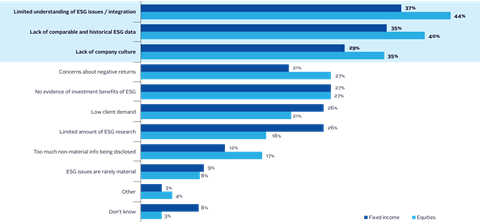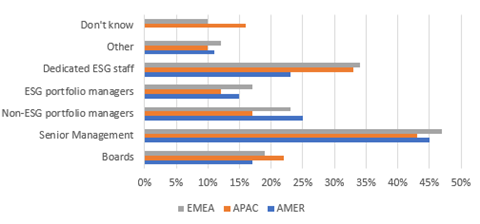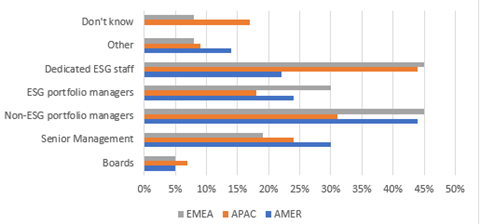By Justin Sloggett (@JustinSloggett), Head of ESG Investment Research, the PRI and Matt Orsagh (@MattOrsagh), Director of Capital Markets Policy, CFA Institute
It’s no secret that although the ESG job market has skyrocketed, investment firms and sell-side research providers have found it hard to recruit professionals with both ESG knowledge and investment experience. ESG teams often lack professionals with investment experience and application, and investment desks largely consist of professionals with limited ESG knowledge and research skills.
This lack of knowledge can cause problems, as the separation of responsibilities for ESG and investment analysis can prohibit the kind of collaborative environment in which ESG issues can be effectively and systematically integrated into the investment process.
There are several reasons for this predicament. Firms with an ESG team or ESG professionals often have used those teams or professionals to examine ESG issues independent of their fundamental impact on an investment. Historically, the focus of ESG roles has been on governance, engagement and voting. This means investment knowledge hasn’t been needed, and ESG professionals have not needed an investment qualification or background.
ESG professionals typically earn less than their peers with investment experience, making it difficult to entice people with investment experience to become ESG professionals. The investment industry has been trying to rectify this skills gap – for example by including investment experience and qualifications as a requirement for vacancies within ESG teams.
Culture is a problem
A major cause for this separation of ESG and investment responsibilities is the lack of company culture. This was found to be the third largest barrier to ESG integration globally, according to the recent reports on ESG integration published by CFA Institute and the PRI.

When ESG and investment teams exist in silos, the two functions can lack rapport, which will mean that the separation between ESG and investment analysis remains. In the case of an integrated investment team, in which the investment teams conduct the ESG analysis, the additional analysis required to assess ESG issues is considered bureaucratic and burdensome. In both structures, investment professionals and teams may still associate ESG integration with negative screening, negative returns and doing good.
As with the bottom up, the right culture is needed from the top down. Senior management come and go, and some are not supportive of ESG integration at the firm level. Those that do have ESG products often do not allocate enough budget or headcount – an ESG analyst can be responsible for an investment universe of hundreds of securities. In these cases, senior management will axe their ESG resource in a recession.
During our CFA-PRI workshop series, one practitioner noted that to realise the investment benefits of ESG issues, senior management need to provide a sustained commitment and not pull ESG resources during bad times. Another practitioner said that ESG factors cannot just be “plugged in” to the investment process. Time, resources, and buy-in from senior management are needed for successful integration.
ESG factors cannot just be “plugged in” to the investment process. Time, resources, and buy-in from senior management are needed for successful integration
Firms should allocate more budget towards ESG resources and tools to ensure that ESG research is embedded in the investment process – including ESG-integrated dashboards, stock sheets and materiality frameworks – and that this information can be accessed by all.
Training and buy-in are key
One of the most effective ways to increase the level of ESG and investment understanding across teams is by offering internal training. South African investors during our workshops agreed that ESG professionals tend not to understand how to quantify ESG issues, look at non-material information, or provide an investment case to portfolio managers.
One delegate at our UK workshop said that ESG professionals tend to speak only about risk, not opportunities, leading to shorter conversations with portfolio managers about losing money from ESG investing.
Because portfolio managers and analysts generally tend not to understand ESG issues, or look at ESG data, they unable to quantify ESG issues. They have trouble identifying which issues are material – and therefore in need of analysis. They also lack the incentives to integrate. Quantification of ESG issues is an issue for many investors. Some finanncial professionals argue that if ESG issues can’t be put in a spreadsheet, the information can’t be integrated.
Portfolio managers and analysts are also concerned by the career risk they associate with ESG integration. If they underperform the market and their peers by integrating ESG factors into their analysis, they risk losing client mandates and subsequently their jobs. They are often reluctant to pursue ESG integration practices without evidence that clearly demonstrates the positive performance related to ESG factors.
Moving forward
Over the past few years, investment professionals have been joining ESG teams, and rapport is building across these two teams. More portfolio managers are aware that ESG integration is not about compromising returns and understand that they can invest in the entire investment universe. These portfolio managers are becoming open to ESG integration and are asking more questions of senior management about ESG topics. An atmosphere of collaboration and appreciation is key to achieve buy-in and results from all parties.
An atmosphere of collaboration and appreciation is key to achieve buy-in and results from all parties
Where the responsibility for ESG integration lies depends on the region, country and firm. On the basis of a survey that accompanied the recent reports on ESG integration, 44% and 45% of investment professionals who responded from the APAC region and the EMEA region respectively, confirmed that their firm allocates the responsibility for implementation of ESG integration to dedicated ESG staff. In the Americas, a higher percentage of non-ESG portfolio managers are responsible for implementation compared with dedicated ESG staff (44% vs. 22%). When asked who was responsible for the oversight of ESG integration, more than 40% responded that their senior management has oversight across all regions (see below).


It is vital to have sufficient capacity to conduct detailed ESG research and training for all staff. These are essential building blocks for creating a culture within firms that is conducive to delivering long-term portfolio returns. We therefore believe that the positive trends in the ESG job market is set to continue for some time with firms hiring more ESG professionals with investment experience and investment professionals with ESG knowledge and expertise.
Read more about ESG integration in the new report from CFA Institute and the PRI.


This blog is written by PRI staff members and guest contributors. Our goal is to contribute to the broader debate around topical issues and to help showcase some of our research and other work that we undertake in support of our signatories.
Please note that although you can expect to find some posts here that broadly accord with the PRI’s official views, the blog authors write in their individual capacity and there is no “house view”. Nor do the views and opinions expressed on this blog constitute financial or other professional advice.
If you have any questions, please contact us at [email protected].












